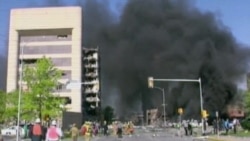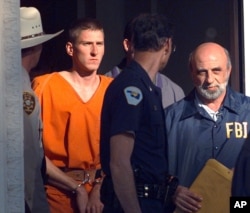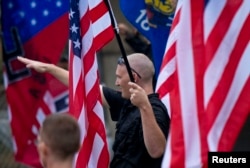The Oklahoma City bombing nearly 22 years ago was an act of domestic terror by U.S. military veteran Timothy McVeigh and his accomplice, Terry Nichols. The bombing destroyed one third of the Alfred P. Murrah Federal Building in downtown Oklahoma City, Oklahoma, killing 168 people and injuring 680 others. In his documentary, Oklahoma City, filmmaker Barak Goodman revisits the bombing as the first major domestic terrorist attack in the United States on April 19, 1995.
It was the number of civilians killed - especially the 15 children, four of them infants, crushed inside the building's day care center - that made this terrorist attack by a massive fertilizer bomb so heinous for many Americans. Many films have recounted the story, but Goodman’s documentary treats the Oklahoma City bombing as a springboard to examine the roots of America's ultra-right militia and to analyze the makeup of homegrown American terrorism.
History of suspicion
“It goes all the way back to the founding of the Republic,” the filmmaker told VOA. "The Republic was founded on the suspicion of government." Goodman says many of these extreme separatists believe in white supremacy and in unregulated freedom to keep and bear arms so that they can protect themselves from outsiders and the government.
In the documentary, former militia member Kerry Noble explains the ideology. “The government is an enemy of the people, and in this war it’s an all or nothing. We’re either gonna win as the white race or we’re gonna lose.”
Oklahoma City points to two events in the late 20th century that bolstered separatist ideologies: The Ruby Ridge incident on August 21, 1992, and the Waco siege in Waco, Texas, between February 28 and April 19, 1993. In both cases, federal and local government agents clashed with American separatists. The deadly incidents were fueled by the authorities' demand to search the premises for illegal firearms.
The Waco siege was particularly deadly. The compound belonged to a group known as the Branch Davidians, led by David Koresh. When federal authorities sent in armed agents and armored vehicles to end the standoff, a fire engulfed the compound, killing 82 people, including David Koresh. Sixty-two of the victims were women and children.
Birth of an extremist
Timothy McVeigh, a Gulf War veteran disillusioned by the government during his tour in Iraq, was among those who went to witness the siege. According to the documentary, McVeigh was radicalized by those events and by an extremist publication called The Turner Diaries.
“It’s a Talisman for the far right, even to this day, but especially back in the '90s and '80s it was the ‘Bible’ of this movement,” says Goodman. “It’s a novel about a small group of ‘patriots,’ ‘white patriots’ who retake the government from the Jews and blacks who have infiltrated it, essentially. It’s a racist creed and as I said, it is very poorly done. Intriguingly though, it describes the bombing of the FBI, the culmination of the novel, and it really lays out a recipe on how to build a bomb like this."
That bomb is very similar to the one McVeigh used in Oklahoma City.
"McVeigh was deeply, deeply influenced by this book," Goodman adds. "He sold it in gun shows, he quoted it, when he was arrested he had several pages of it in a folder beside him in a car. And it wasn’t just McVeigh, it was all through this movement. People were really exorcised, impassioned, inflamed by this novel."
The documentary shows McVeigh obsessed with his guns and with the idea that the government was going to take them away. The film also points out that his exposure to the war in Iraq accelerated his feeling of mistrust of the U.S. government.
“The way he put it made it sound he was emphatic towards the dead Iraqi soldiers that he killed. I really don’t think that’s the case,” says Barak Goodman. Instead, says the filmmaker, it was McVeigh’s mistrust of the U.S. government, how it had blundered into Iraq and his idea of the U.S. government as a bully, and McVeigh, says Goodman, hated bullies. The Ruby Ridge and Waco stand-offs reinforced that idea in his mind.
Homegrown extremism
According to the documentary, there are 500 militia organizations in the U.S. today. Goodman believes they are as radicalized as ever. “Some of them have gotten rid of their camouflage outfits and put on suits and ties, but really the rhetoric has been virtually the same for 100 years or more. ‘It’s a whites-only country, it should be a whites-only country, the federal government is in the hands of Jews, blacks, it’s a conspiracy.'”
Goodman says it is a misconception to believe that this is a movement of white poor disenfranchised people. Certainly, he says, many are, but there also many professionals feeling a loss of entitlement, a loss of privilege and power. The filmmaker stresses that these people operate outside political parties and share a deep mistrust of the Washington political establishment.
But Goodman cautions these extremists are not de facto terrorists. He says it takes a confluence of opportunity and a warped personality, often a lone individual, to commit a terrorist act of a scale such as the Oklahoma City bombing.
“McVeigh was a shock to most people in the FBI. It would be less of a shock today. But it’s very hard to prevent these things. One of the takeaways from our film and audiences who have seen it have been amazed at how really easy it was to do this. It cost about $6000, it was one guy, reading some literature,” says the filmmaker.
Goodman says in a politically polarized America, the possibility for future domestic terrorist attacks is high.
“If you talk to people from the Southern Law Poverty Center, which tracks these groups, they are pounding on the wall, they are ringing the bell, they are saying, ‘This is an ongoing threat, it’s threat level midnight, it's rising, it's whatever the highest color is on the chart,'” he says.
The SPLC reports, “the number of hate groups in the United States rose for a second year in a row in 2016 as the radical right was energized by the candidacy of Donald Trump.” “The most dramatic growth,” it states, “was the near-tripling of anti-Muslim hate groups – from 34 in 2015 to 101 last year.” Also, a wave of bomb threats and vandalism has rattled Jewish institutions around the country, but especially in the South. “Right now, minorities feel particularly threatened,” says the Oklahoma City filmmaker.
“There is a very big difference between even hard gun rights activists and terrorists. I want to make that clear,” says Goodman. “I would take issue with the idea that they have infiltrated the administration. But it is a little galling to see the really mono focus on terrorists from abroad, terrorists influenced by ideas from abroad, whatever those ideas might be, and not on any real discussion about home-grown terrorism which has always been with us and which is not going away and which is actually -- if you look at the numbers of the incidents -- rivaling or exceeding those by that other group,” he adds.
Goodman hopes his film, Oklahoma City, will call attention to this rising threat and contribute to the conversation on the inherent dangers of domestic terrorism.










